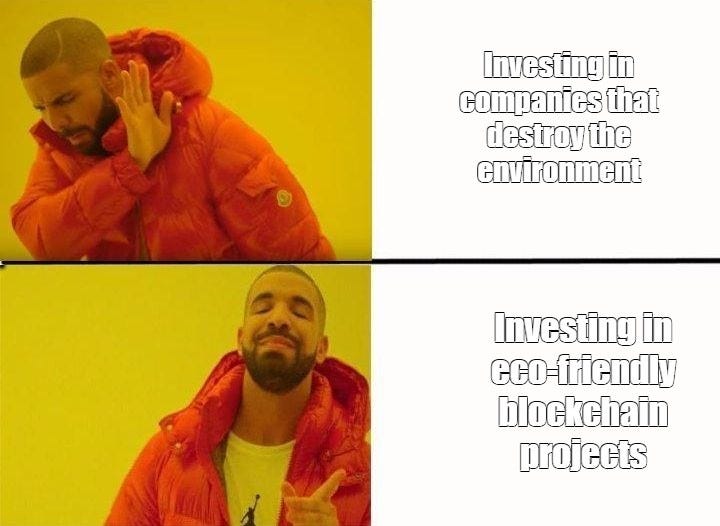How to Make Your Digital Currency Choices Eco-Friendly 🌎
by Russian Defi
Trying To Find Green Crypto🌱
Due to the complex computation required, cryptocurrency mining typically uses a lot of energy. Alternative models with a low environmental impact have been developed to minimize the carbon footprint associated with digital currencies: the so-called green cryptocurrencies.
Sustainability is increasingly being used as a critical metric for the blockchain industry’s future. The crypto space must develop efficient and effective cryptographic mechanisms to increase the adoption of blockchain-based cryptocurrencies. The process of creating and maintaining blocks of information, or how the users of a particular cryptocurrency have agreed to record and validate the information contained in each block of the distributed database, must be examined to evaluate the energy efficiency of that currency.
Instead of relying on mining, block lattice-based cryptocurrencies use a system called “Proof of Storage” or “Proof of Stake,” which uses much less energy. However, even among cryptocurrencies with “Proof of Work,” some require more energy than others. This is primarily because these coins use ASIC-resistant algorithms that use much more energy than is reasonable, given how much of the crypto market they account for.
It’s challenging to label any particular currency as “greener” than others due to the large number of factors involved. For instance, many smaller cryptocurrencies naturally have a much lower energy footprint than Bitcoin because they experience far fewer daily transactions.
Bitcoin Energy Consumption⚡️
More than 198 terawatt-hours (TWh) of electricity are assumed to be consumed annually by the Bitcoin industry, comparable to Thailand. According to the Bitcoin Energy Consumption Index published by Digiconomist, this energy-intensive use results in nearly 95 million tons of CO2 emissions annually, similar to those of countries like Nigeria.”
These rising numbers have also been the subject of media attention by Tesla CEO Elon Musk, who announced in May 2021 that his electric car company would no longer accept Bitcoin as payment. Other studies, such as that of the Judge Business School at Cambridge University, have confirmed these statistics.
Bitcoin has a high energy consumption; the primary cause is an inefficient mining system or consensus mechanism known as Proof-of-Work (PoW).
Even though the energy requirements of Bitcoin are comparable to those of a small country, it is still regarded as one of the best Proof-of-Work coins. However, the cryptocurrencies listed below differ from Bitcoin because they actively lower their contribution to global warming.
Which cryptocurrencies are environment-friendly? 🌍
Some recent cryptocurrencies combine renewable energy with different validation techniques to produce a token that consumes much less energy than its predecessors.
1. SolarCoin (SLR)
Global, decentralized, and unconstrained by any authority, SolarCoin is like other cryptocurrencies that can be spent and traded, but its main distinction is that it aims to encourage verifiably produced solar energy, a real-world environmental activity.
2. Algorand (ALGO)
Few cryptocurrencies have demonstrated a more substantial commitment to sustainability than Algorand. On Earth Day 2022, it announced that it is a carbon-negative blockchain and blacked out nearly 20 billboards in Times Square.
Algorand, like other blockchain platforms, can compete with Ethereum by supporting smart contracts, and as it uses the proof-of-stake model to validate transactions, it already has a low carbon footprint.
3. Powerledger (POWR)
The Powerledger platform is powered by the token POWR, created in 2016/2017. When it first appeared on Coinbase in November 2021, the token’s price increased quickly despite a market-wide crash that saw most cryptocurrencies crash.
To use the Powerledger network’s various products, such as energy trading, clean energy tracking, and verification, POWR is required.
4. Solana (SOL)
Solana, a proof-of-stake blockchain with smart contract functionality, was one of the best cryptocurrency investments of 2021. It generated more than 11,000% returns and turned the company carbon neutral for the year.
Solana is best known for its quickness and effectiveness. It reportedly can handle up to 65,000 transactions per second and routinely processes more than 2,000 per second. The average transaction cost is just $0.00025.
5. Nano (XNO)
Nano aims to offer a sustainable, fee-free digital currency system. Its entire guiding principle is to make using its system simple and affordable. Unlike other cryptocurrencies, Nano doesn’t keep a chain containing a record of every transaction. Instead, Nano accounts are a network of interconnected blocks that each user can control. Each transaction uses so little energy that standard computers can power it.
6. Cardano (ADA)
Charles Hoskinson, an Ethereum co-founder, created Cardano, which scientists and academics used as the first peer-reviewed blockchain. Although its primary use is as a digital currency, it can also be applied to dApps, digital contracts, and other things. Cardano can process 1000 transactions per second instead of Bitcoin’s 7 transactions per second.
Cardano uses a “Proof of Stake” consensus mechanism, where users of the currency purchase tokens to join the network, making it more energy efficient than Bitcoin. This helps conserve an incredible amount of energy; according to the founder of Cardano, the cryptocurrency network only uses 6 GWh.
7. Stellar (XLM)
To bridge the gap between conventional financial institutions and digital currencies, the Stellar network was introduced in 2014 (forking off from Ripple). Stellar does not charge institutions or individuals using the network. Due to its ability to facilitate quicker, simpler, and more affordable cross-asset and cross-border transactions, it is becoming increasingly recognized as a serious PayPal alternative.
8. EOSIO (EOS)
Developers love EOSIO, a public blockchain that is free to use, easy to set up, and on which they can write applications in various programming languages.
Using pre-mined EOS tokens that can be traded on well-known cryptocurrency exchanges like Coinbase, Binance, and Kraken, EOSIO is another “Proof of Stake” platform.
9. TRON (TRX)
TRON is a non-profit company with a public blockchain that supports almost all programming languages. It is based in Singapore. Creators can now share applications directly on the blockchain thanks to the peer-to-peer platform, which also increases the process’ energy efficiency.
TRON uses a Delegated Proof of Stake (DPoS) consensus mechanism, which is more energy-efficient compared to other PoW and PoS mechanisms.
Environmentally sustainable blockchain gaming 🎮
The market has provided us with some fantastic green initiatives, like the Web3 gaming metaverse Planet Mojo, developed by former LucasArts, EA, Activision, and ILM employees. They are developing a blockchain game that is “fun-first” and environmentally sustainable.
The project’s long-term objective is to build a viable world and platform for the next generation of gamers, where they can own their in-game possessions and have a say in how Planet Mojo will develop in the future.
Around the world, 40 million trees have already been planted by One Tree Planted. Planet Mojo shows that the creators and users of the metaverse care about a greener future by working with One Tree Planted.
While there is still much to be done to fully “greenify” the metaverse, Planet Mojo is starting by establishing green guidelines.
Final Thoughts 💭
Numerous green cryptocurrencies are available on the market. Virtually all cryptocurrencies that don’t employ the proof-of-work model will use much less energy.
With widespread adoption, improvements in consensus algorithms, and a focus on using renewable energy sources, the overall environmental cost of cryptocurrencies and blockchain networks would be reduced. Legacy mining operations’ e-waste is still a problem that needs to be addressed. However, non-PoW cryptocurrencies might make it less necessary to construct bigger and newer mining rigs in the future, which could assist in reducing waste.






